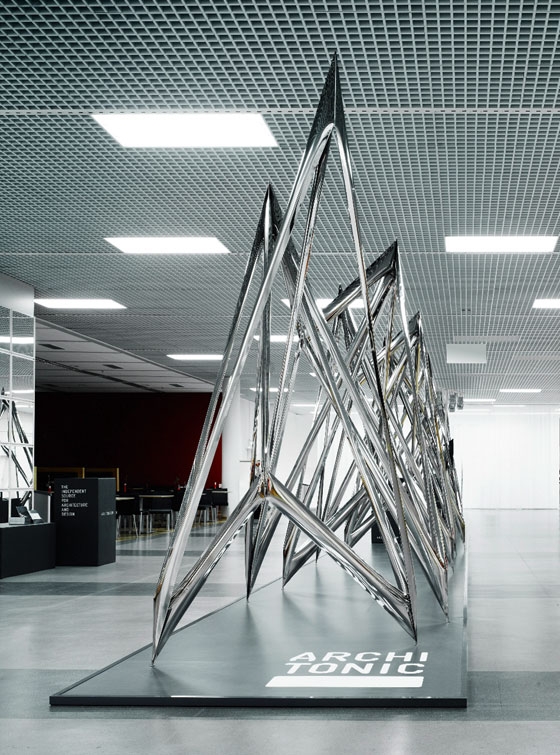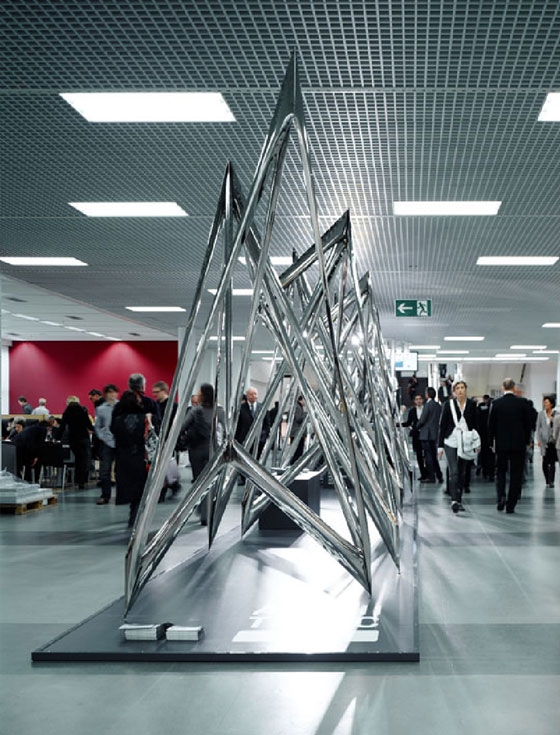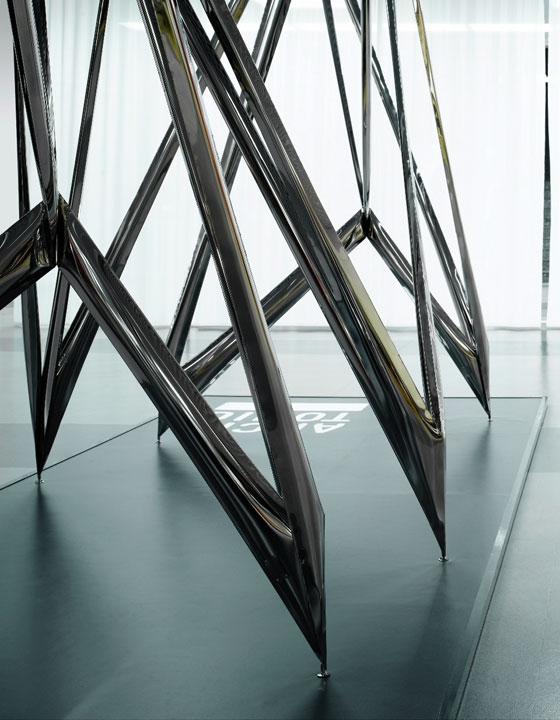The Architonic Pavilion has been designed and produced by Zieta Prozessdesign in FIDU technology. FIDU allows to:
- create unique and individualized forms and produce them cost-effectively;
- create light and efficient constructions;
- increase ecology and cost-efficiency of steel-objects production;
Zieta Prozessdesign develops FIDU technology and researches the possibilities of its application to the constructions of home objects, furniture, public elements and small architecture. Each of these fields is a new challenge in the forming process in FIDU technology.
The development of new forms means experimenting with different shapes to develop the whole range of new systems and to constantly present more complex design objects in FIDU technology. Zieta Prozessdesign combines 3 forces – research, design and production to bring the most complex solution and to eliminate any imperfections or inefficiencies on any stage of bringing concepts to life.
Architonic Pavilion is a next step on a way to develop new applications of FIDU technology in light constructions.
About brief
Design brief presented to us by Architonic and Messerli (logistics cooperating company) was very precise. It has precisely defined the modules of elements, the diversity of exhibition spaces and the assembly times. These parameters have defined our design line.
Working on a concept, we began our experiments with a flat form of a rectangle. It has been deformed into a hyperbolic shape to bring a form of a tunnel. To increase stability and enhance the dynamic look of a form, the centre of a shape has been lowered.
The final form has some characteristics of a form called hyperbole - a form which belongs to a group of a Non-Euclidean geometry. Basic research and analyses of these kinds of objects were undertaken in the beginning of XIX century by mathematicians: Janos Bolyai, Nikolai Ivanovitsch Lobatschevski and Carl Friedrich Gauss. Our basis to the conceptual work was a hyperbolic paraboloid.
About requirements
The elements of the Pavilion needed to fulfil many requirements. Installations like this have to be light and durable, easy to transport, easy to assembly and durable enough to maintain their quality during all the events, fairs and exhibitions. This is why we chose inox steel in its raw form – with no lacquer. The elements of the Pavilion have to fit to the dimensions limited by the exhibition spaces available during the festivals and design fairs.
About joints and a final form
The aim was to design a stabile, light and durable form with a load carrying capacity, taking advantage of the full potential of FIDU technology. To stabilize the conceptually-designed object, we had to prevent the movement in any axis in the joints. After experimenting with prototypes and a delicate re-conception we created elements which are called ‘the knots’. There are two kind of knots in every module - one on the inside of a module, formed by four bars, and one on the outside of module formed by three bars – a bar from an inside knot and two outside elements.
These joints stabilize an object in all possible directions and simultaneously create an interesting space composition. They give a full 3d possibility to FIDU technology, or at least show one of the methods to reach it. High glossiness of Inox gives an interesting effect of light and the reflections of each element. It is a combination of a strong and durable construction and attractive relations between all the elements.
Each single element of a construction is configured to stabilize and influence the appearance of the whole structure. There is a ‘chaotic parameter’, which creates a visually-attractive installation. The task of a chaotic parameter is to perturb the repeated pattern of a structure. Elements in each module can be positioned in different configuration and the inside knot can be re-positioned in x,y or z axis. This kind of experiments with a configuration gave a dynamic look to the structure. The pattern is still visible, but if the modules were put together in a different way, it would be gone. The most important step was to find the crucial relationships between single-elements, their joints, the modules and to set the final characteristics and positions of all the elements together and to create a highly-interesting visual effect of the whole structure.
About transport
One of the requirements known from the very beginning of the process was to make elements fit the standard cargo container. This requirement was fulfilled by enabling the modules to fit one another just like it is done with most of the common chairs. Putting one module into another gives high space-efficiency in transport and storage.
About packaging
Easy-to-scratch Inox surface needs to be handled with care and specially protected in transport. We used PE-foam of individually-calculated density, thickness and hardness – harder foam would scratch Inox, and softer would be less durable. The durability of the foam guarantees that it can be used many times.
Architonic AG







